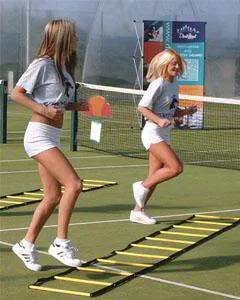My quick thoughts on the speed ladder; the good and the bad. Many coaches believe that the speed ladder is an effective way to develop increased foot speed. I'm not even sure what foot speed is since explosive, quick movement comes from the power of the hips, and stability of the torso to keep energy leaks to a minimum. The glutes, hamstrings, hip flexors, etc. are the power houses associated with quick, explosive movement.
I do believe there are some good uses for the speed ladder but they are more appropriately applied to young kids. They can be great to help young athletes develop, coordination, body control, and learn how to coordinate arm movements with leg movements. The ladder can be a great tool for prepatory jump training with kids, as well as with some older athletes as well.
Now one of the reasons I don't like speed ladders. We've all seen athletes who could run circles around others in a speed ladder but do nothing of any sort on the playing field. They basically have become super efficient at the closed ended, pre-programmed motor patterns. That's all a speed ladder pattern is. Sports aren't played in that format and that is why the speed ladder essentially has no carry-over what-so-ever to any type of sport. Sports are played using open-ended motor skills based on reaction to a one or many stimuli. Don't buy into thinking that the speed ladder is really doing anything for speed or "foot quickness." When does an athlete move their feet 100 mph without their body going anywhere? If they are their probably getting run by or run over. In any case it isn't good.
Any tool can be used for small time frames but if a speed ladder is one of your main tools throughout the year then it may be time to re-evaluate your program. Wouldn't it be much better to get athletes performing movements that simulate what they perform in competitions than to just mindlessly run through ladders believing this will increase your third baseman's ability to get to a ball down the line.
Train your athletes how they play. Design agility patterns that incorporate movements similar to their position requirements. Then add variety by making them have to react to a stimulus such as a coach pointing different directions or calling out numbers that each stand for a different cone. The variations are only limited by a coach's imagination.

